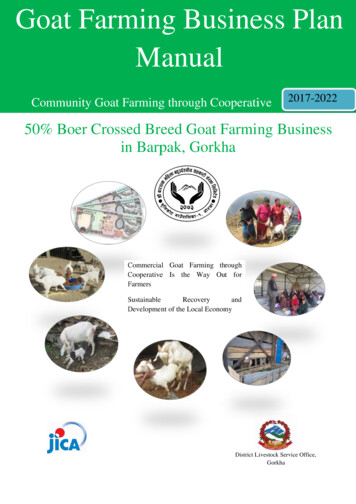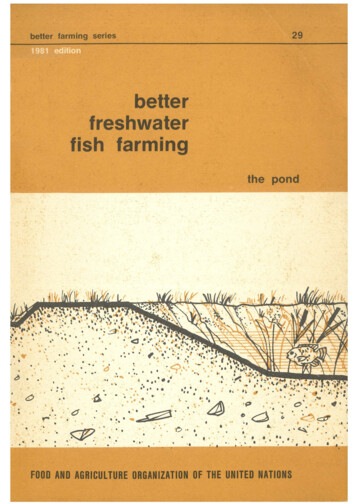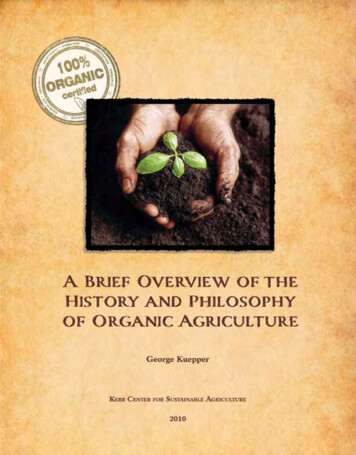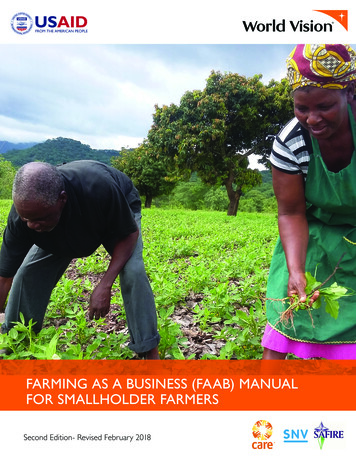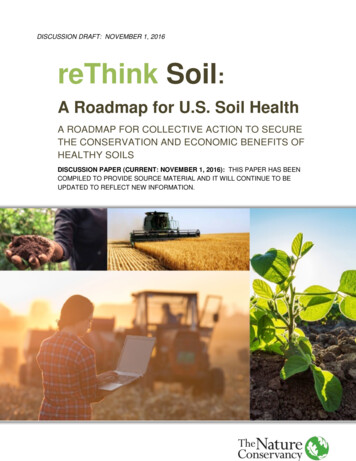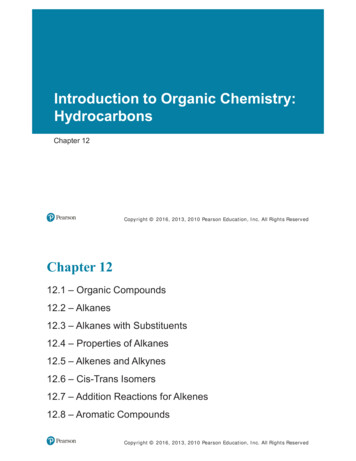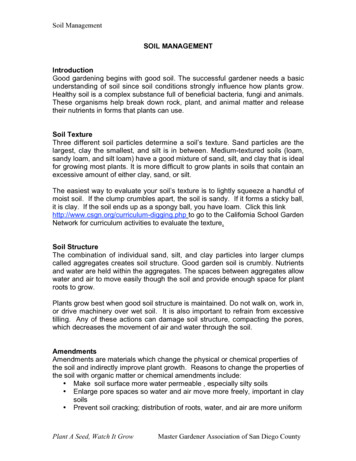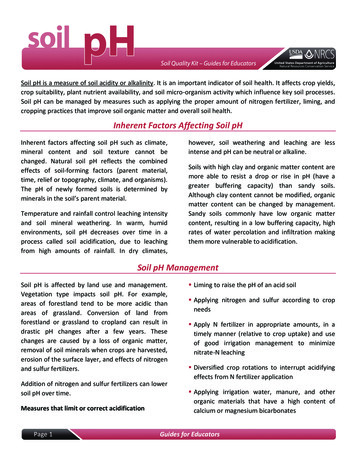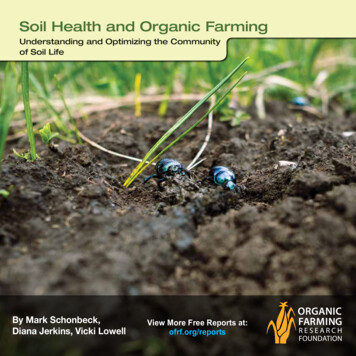
Transcription
Soil Health and Organic FarmingUnderstanding and Optimizing the Communityof Soil LifeBy Mark Schonbeck,Diana Jerkins, Vicki LowellView More Free Reports at:ofrf.org/reports
SOIL HEALTH AND ORGANIC FARMINGUNDERSTANDING AND OPTIMIZING THECOMMUNITY OF SOIL LIFEAn Analysis of USDA Organic Research andExtension Initiative (OREI) and OrganicTransitions (ORG) Funded Research from 2002-2016Thank you toLundberg Family FarmsUNFI FoundationSpecial thanks to theClarence E. Heller Charitable Foundationfor supporting the Soil Health and Organic Farming series. 2019 Organic Farming Research Foundation Santa Cruz, CA
Table of ContentsIntroduction. 1Soil Biology 101. 5Soil biodiversity, habitats, and functional groups. 6The central role of plants in the soil food web. 9Organic Practices for a Living Soil.12Challenges in managing the soil life for sustainable organic production.12Soil biology monitoring and assessment .13Managing soil biology for optimum soil, crop, and environmental health.16Concept #1: Can Soil Organisms Live with Tillage?.18Fine-tuning the system: crop-preferred microbiomes.21Fine-tuning the system: nutrient cycling, n2 fixation, and mycorrhizal fungi.23Concept #2: Best Management Practices for Soil Life.25Biological Management of Crop Diseases.26Soil habitat modifications .28Biofungicides. 30Concept #3: Tips for Successful Biological Management of Plant Diseases.31Microbial Inoculants and Other Biostimulant Products.32Purchased products: navigating the microbial input smorgasbord.32Growing your own soil inoculants.35Concept #4: Making On-Farm AMF Inoculant.36Concept #5: Getting the Most out of Microbial Inoculant Applications.38Chapter 5: Resources. 40Getting to know the soil biotic community. 40Monitoring soil life and soil health.41
Practical applications: enhancing soil food web function and on-farm productionof microbial inoculants.41Practical applications: managing pathogens and pests.43Keeping up with research developments in soil biology and organic agriculture.45A Taxonomic Tour of the Soil Biota.47Bacteria.47Archaea. 48Actinobacteria or Actinomycetes.49Fungi.49Protozoa and slime molds. 50Algae.51Nematodes.51Micro-arthropods: mites and springtails.52Earthworms.53Larger arthropods: ants, termites, dung beetles.55Burrowing vertebrates.55Viruses.56Research Topics.56Assessing soil biotic communities and biological functions.56Soil life, soil organic matter, and moisture holding capacity.58Impacts of crop rotation, inputs, and management practices on the soil biotaand nutrient cycling.59Promoting Mycorrhizal Fungi.63Disease and pest suppression.65Plant genetics and plant-microbe interactions.69Priorities for additional research.71Literature References. 73
IntroductionThe life in the soil provides the foundation for successful farming, and for all terrestrial plant, animal, and human life on Earth. A diverse community of soil bacteria, fungi, protozoa, worms, arthropods, and other organisms, commonly known as the soil food web, converts fresh residues into soil organic matter (SOM), and playsa central role in each of the soil functions considered essential for agricultural production (Figure 1, Table 1).Figure 1. The soil biotic community, or soil food web, conceptualized as a series of trophic levels, each feeding onthe preceding one. Ingham, E. R., A. R. Moldenke, and C. A. Edwards. 2000. Soil Biology Primer. Soil and WaterConservation Society (SWCS). Rev. ed. Ankeny, IA.UNDERSTANDING AND OPTIMIZING THE COMMUNITY OF SOIL LIFE1
Ever since the dawn of organic agriculture in the early 20th Century, ecologically-minded farmers andranchers have understood that “if you feed the soil, the soil will feed the plant.” While early leaders such asSir Albert Howard (1947) and Ehrenfried Pfeiffer (1943) intuited that soil organisms nourish plants, therewere no research methods that could elucidate precisely how this occurs. As a result, mainstream agricultural scientists of their time discounted soil life and organic matter as key factors in soil fertility and plantnutrition (Montgomery, 2017).Historically, producers and agricultural professionals have described the soil’s capacity to meet the requisites for successful production—nutrients, moisture, aeration, workability, and stability—as soil quality.With growing understanding that only a living, biodiverse soil with sufficient soil organic matter (SOM) cansustain crop and livestock production over the long run, farmers and professionals have adopted the termsoil health.Over the past 30 years, extensive research has begun to elucidate the many trophic levels and functionalgroups of the soil food web, and how an optimally functioning soil biota feeds and protects crops, reducesrisks, and strengthens farm economic viability (Ingham et al., 2000; Figure 1). For example, 20th centuryservice providers cited the fact that soil microbes initially immobilize (tie-up) plant nutrients in organic residues as the reason organic farming “won’t work.” It is now widely understood that these nutrients are notlost but conserved, and that diverse soil organisms work together to recycle nutrients, protect water quality,provide for plant nutrition, and enhance crop resilience to stresses. Table 1 summarizes the roles of differentsoil organisms in key soil functions and ecosystem services.2UNDERSTANDING AND OPTIMIZING THE COMMUNITY OF SOIL LIFE
Table 1. Soil Life and Soil FunctionsSoil FunctionsSome Key OrganismsCROP PRODUCTION NEEDSPlant nutritionRetains and recycles nutrientsfrom organic residuesDecomposer bacteria and fungi,earthworms, arthropods*Delivers nutrients to plants.Protozoa, nematodes, N fixingbacteria, mycorrhizal fungiMaintains SOM, aggregationPlant-available moisture(tilth), network of small and largeDrainage and aerationpores, deep channels.Crop protectionBacteria (glues), fungi (mycelia),earthworms, arthropods, plantroots, (pores, channels, exudates)Deters plant pathogens,nematode and other pests.Pathogen antagonists,predators and parasites of pestsEnhances plant disease and pestresilience.Microbial symbionts that inducesystemic resistance (ISR)ECOSYSTEM SERVICESWater qualityMinimizes leaching and runoff.Retains nutrients.Attenuates plant, animal, andDetoxification human pathogens. Binds ordestroys toxins.Carbon sequestrationBuilds stable soil organic matter(SOM).Plant roots and cover, microbes thatimmobilize nutrientsDung beetles, microbes thatdegrade organic wastes andpesticides, or bind heavy metalsPlant roots, fungi, bacteria, deepburrowing earthwormsSOIL SELF-MAINTENANCEStability against erosionProtects soil surface, maintainssoil aggregation.Plant cover and roots, fungi(hyphae), bacteria (glues)Resilience and tilthRestores structure after tillage,grazing, traffic, or downpour.Plant roots, earthworms,arthropods, fungiDigests manure and plantresidues into SOM.Decomposer bacteria and fungi,earthworms, arthropodsActive and stable SOMFood and habitat Builds active SOM, maintainsfor soil life large and small pore spaces.Plant roots (exudates), fungi,bacteria, earthworms, arthropods* Mites, springtails, ants, termites, ground beetles, dung beetles, centipedes, millipedes, etc.UNDERSTANDING AND OPTIMIZING THE COMMUNITY OF SOIL LIFE3
Since organic systems rely to a great degree on the soil food web for crop nutrition and crop protection,practitioners protect soil organisms by avoiding the use of synthetic chemicals. Organic farmers build soillife by adding compost and other organic materials, diversifying the crop rotation, growing cover crops,utilizing legumes to provide nitrogen (N), and integrating crops and livestock. They conserve soil life bylimiting tillage, pesticide sprays, and concentrated fertilizers inputs (Baker et al., 2016; Schonbeck et al.,2017). In a meta-analysis of 56 studies conducted around the world, organically managed soils maintained32 – 84% greater microbial biomass and enzyme activity than the same soils managed conventionally (Loriet al., 2017).The explosion of information on soil life presents farmers at once with exciting possibilities and mindboggling complexity. For example, vendors of organic amendments offer dozens of microbial inoculants andbiostimulant products, which they claim will prevent disease, enhance nutrient uptake and plant growth,or improve soil food web function. The efficacy of specific products (e.g., mycorrhizal inoculant) or practices (e.g., cover crop) in optimizing soil biology or suppressing disease varies with climate, soil type, croprotation, and production system. Thus, identifying the best inputs and practices for a particular site can bechallenging.The goal of this guidebook is to help organic farmers navigate the wilderness of soil life and soil health management by providing up-to-date, science-based information on: The soil food web, its key components, and functions. Assessing and monitoring soil life and soil biological condition. Managing soil life for long term soil health and productivity in organic systems. Biological management of plant diseases. Microbial inoculants and biostimulants: whether, when, and how to use them.4UNDERSTANDING AND OPTIMIZING THE COMMUNITY OF SOIL LIFE
Soil Biology 101The community of soil life or soil food web consists of: Soil organisms, including:–– Microbiota or microbiome – bacteria, archaea (a separategroup of bacteria-like microbes), fungi, protozoa, andsmall nematodes.–– Mesofauna – mites, springtails, larger nematodes, andother organisms 0.1 – 2 mm (1/250 – 1/12 inch) in length.–– Macrofauna – larger insects, earthworms, mollusks,burrowing vertebrates, etc. Their food, water, and air supply. Their habitat or living space.Many farmersconsider the soil lifetheir “undergroundlivestock,” whichthey must keepfed, watered, andsheltered as theydo their herds andflocks. Plant roots. The web of trophic (food chain), cooperative (symbiotic),and antagonistic (competitive, parasitic, or antibiotic)relationships among soil organisms and plant roots.With a total live weight of 1,700 – 27,000 lb/ac, the soil biota accountsfor just 1 – 5% of total SOM (Weil and Brady, 2017), yet they regulateessentially the entire stock of SOM. Recent research indicates thatnearly all stable SOM (“humus”) is derived from microbial processingof plant residues, and consists largely of microbial remains and metabolites tightly adsorbed to soil minerals (Kallenbach et al., 2016). As soilorganisms digest fresh residues and active SOM for their own nutritionand growth, they provide both crop nutrition and long term SOM stabilization and carbon (C) sequestration (Figure 2).UNDERSTANDING AND OPTIMIZING THE COMMUNITY OF SOIL LIFE5
Figure 2. Soil life plays a central rolein plant nutrition, soil health, and theglobal carbon (C) cycle. Soil organismsprocess all organic inputs from plants,animals, and their remains, releasingsome as respiratory carbon dioxide(CO2) and plant nutrients, andconverting the rest into new biomass andultimately soil organic matter (SOM).The active fraction of SOM undergoesfurther processing, while stable SOMremains sequestered for decades tomillennia.Soil biodiversity, habitats, and functional groupsMost soils show incredible biodiversity, with thousands of microbial genotypes and hundreds of meso- andmacro-fauna species present in a single handful of topsoil (Weil and Brady, 2017). This diversity allowsthe soil life to adapt in response to seasonal shifts in temperature, moisture, and plant community; and todisturbances such as fire or grazing. Agricultural soil food webs change dynamically over time in responseto crop rotation phase, tillage and other field operations, and weather conditions. In addition, soil microbialcommunities evolve continually by sharing genetic material in a process known as “horizontal gene transfer,” that renders the very concept of “species” difficult to define (Weil and Brady, 2017). Thus, in lieu ofattempting to catalogue the soil biota by species, soil scientists focus on functional groups of soil organismsand their roles in agricultural production (Table 2).6UNDERSTANDING AND OPTIMIZING THE COMMUNITY OF SOIL LIFE
Table 2. Some key functional groups of soil organismsFunctional groupEnergy and carbon sourceOrganismsPhotosynthesizersSunlight atmospheric CO2 .Plants, algae, cyanobacteriaChemo-autotrophs*Inorganic compounds CO2Specialized archaea and bacteriaDecomposersOrganic residuesBacteria, fungiGrazersBacteria, archaea, fungiProtozoa, nematodesPredatorsVarious soil organismsNematodes, arthropodsShreddersOrganic residues microbesMicro-arthropodsEcosystem engineersOrganic residues organismsEarthworms, termites, ants, dung beetlesPlant symbiontsLiving plant rootsRhizobia, other N2 fixers, mycorrhizalfungi, other beneficial endophytesPlant pathogens andherbivoresLiving plant tissuePathogenic fungi and bacteria, rootfeeding nematodes, grubs, rodents, etc.* These include microbes that oxidize ammonium-N (nitrifying bacteria), sulfur, iron, and other micronutrients; theycan play important roles in plant nutrition.Decomposer bacteria and fungi begin the process of recycling organic residues (dung, plant litter, etc.),initially immobilizing (binding) N and other nutrients that might otherwise be lost from the soil-plant ecosystem. Protozoa and small nematodes, collectively known as grazers, release plant-available nutrients asthey feed on bacteria and fungi. Higher trophic levels of predators release additional nutrients and regulatepopulations of grazers and some plant pests.Larger organisms, including mites, springtails, insects, and earthworms, facilitate microbial processes byshredding and incorporating organic residues into the soil. The soil’s ecosystem engineers, including earthworms and dung beetles, play key roles in soil structure, drainage, SOM, and nutrient cycling. Earthwormsingest organic residues and mineral soil, excreting the latter as aggregated castings enriched in nutrients,SOM, and beneficial microbes.Nitrogen-fixing microorganisms and mycorrhizal fungi play central roles in agricultural production, and inUNDERSTANDING AND OPTIMIZING THE COMMUNITY OF SOIL LIFE7
all life on Earth. Without microbes equipped with nitrogenase en-“The diversity of substratesand environmentalconditions found in everyhandful of soil spawnsa diversity of adaptedorganisms that staggersthe imagination.The collective vitality,diversity, and balanceamong these organismsmake possible the functionsof a healthy soil.”(Weil and Brady, 2017,The Nature andProperties of Soils,p 464).zyme to convert elemental nitrogen (N2) into plant-available N, ourcrops, livestock, and humanity itself would be unable to access theatmosphere’s huge reserve of this essential element. N2 fixers includenodule-forming plant-symbiotic Rhizobium and Bradyrhizobium bacteriain legumes, Frankia actinomycetes in several plant families of trees andshrubs, free-living N-fixing bacteria such as Azotobacter, which utilizeorganic residues or root exudates as carbon sources, and some of thephotosynthetic cyanobacteria.Mycorrhizal fungi associate with about 80% of plant species, including 70% of agricultural crops, growing into root tissues and extendinginto the soil, thereby vastly enhancing effective volume, and moistureand nutrient absorptive capacity of roots. Fossil evidence indicates thatmycorrhizal fungi co-evolved with the earliest land plants more than400 million years ago.While mutualists like N2-fixing microbes and mycorrhizal fungi repaytheir hosts’ investment of photosynthetic product, other plant-feedingsoil organisms are “freeloaders” that can damage the plant. Theseinclude various fungal and bacterial pathogens, root-feeding nematodes, and soil macrofauna such as grubs, rootworms, and voles thateat plant tissues wholesale. In addition, deleterious rhizobacteria do notattack plants directly, but release substances that slow plant growth orotherwise cause subtle degrees of injury. An abundant and diverse soilmicrobial community generally reduces damage from plant pathogens.Soil habitat diversity underpins soil biodiversity. Soil organisms inhabitthe surfaces of soil mineral particles, surface and interior of organicmaterials and soil aggregates, and a network of pores and channelsvarying in diameter from less than 1 μm (a millionth of a meter, or8UNDERSTANDING AND OPTIMIZING THE COMMUNITY OF SOIL LIFE
1/25,000th inch) to one inch or more. While soil biological activity isgreatest in the topsoil, soil organisms extend at least as deep into thesoil profile as plant roots. This mosaic of habitats offers a wide range ofmoisture and oxygen levels, temperature regimes, pH, and organic andmineral nutrient levels, and thereby supports soil microbial diversitythat may be 1,000-fold greater than in aboveground or aquatic ecosystems (Williamson et al., 2017).Microbial habitats also include plant root tissues and the digestivetracts of larger organisms such as mites and earthworms, where themicrobes play vital roles in their hosts’ nutrition and health. In turn, thedaily activities of roots, earthworms, and other soil organisms continually re-create and maintain soil structure and habitat, including bothair- and water-filled pore space.The central role of plants in the soil food webNo soil ecosystem would survive without living plants, the bridge between above- and below-ground life, and the “solar collector” on whichall terrestrial life depends. As the primary food source for the soil biota,as well as the main “consumer” of soil food web services, plant rootsFigure 3 – The rhizosphere, or root zone,hosts great numbers and diversity of soilorganisms (green). Nourished by plantphotosynthetic product delivered via theplay a central role in the soil ecosystem. Roots occupy roughly 1% ofroot system (blue), bacteria and fungithe soil volume, account for a quarter to a third of total soil respiration,multiply on or near the root surface, andand create an enriched habitat for soil organisms known as the “rhizosphere” (Weil and Brady, 2017; Figure 3). Prolonged fallow periodssome grow within root tissues as endophytes.Mycorrhizal symbionts and microbial grazerssuch as protozoa and nematodes providewithout living roots put soil life on a “starvation diet,” deplete SOM,plant-available nitrogen (N) and otherand harm soil health (Engel et al., 2017; Moncada and Sheaffer, 2010).nutrients (red).The growing root feeds soil life by exuding sugars and other organiccompounds, and by sloughing spent cells from the root cap and rootsurface. These inputs are collectively known as “rhizodeposition.”UNDERSTANDING AND OPTIMIZING THE COMMUNITY OF SOIL LIFE9
Plants also deliver organic materials directly to mycorrhizal fungi, N fixing-rhizobia (legumes), and othermicrobial symbionts. Many plants associate with arbuscular mycorrhizal fungi (AMF), whose mycelia grow outinto the soil and into root tissues, where they form distinctive structures called arbuscules in which the mutualistic exchange of photosynthetic product for phosphorus (P), other nutrients, and moisture takes place.Forest trees and some other woody perennials host ectomycorrhizal fungi, which form a dense, close-fittingnetwork of mycelia around the root to accomplish a similar exchange.Mycorrhizal fungi can link root systems of different plant species to mutual benefit in forest, prairie, andagricultural ecosystems. A grass-legume crop mix features a four-way symbiosis, in which a single AMFmycelium can “ship” legume-fixed N to the grass, and surplus P absorbed by the grass to the legume(Figure 4). AMF can enhance N-fixing efficacy of legume nodule rhizobia, as well as rhizosphere speciessuch as Azotobacter and Azospirilum (Drinkwater, 2011; Hamel, 2004).Figure 4 – A four-way symbiosis among grass, legume, rhizobia,and AMF fungi enhances forage vigor in pasture. The plantssupport their microbial symbionts with photosynthetic product(blue), while the rhizobia fix N (red) and AMF absorb P (orange)for their hosts. The grass is more effective in P uptake, and isotopetracer studies confirm that a two-way exchange of N and P takesplace via AMF links between the two plant types. Based oninformation provided by Weil and Brady, 2017, page 501.In healthy soils with low to moderate levels of soluble nutrients, plants may contribute 20 – 40% of their photosynthetic product to the soil life through rhizodeposition, mycorrhizae, and other symbiotic relationships.For example, legumes may invest 20% of their production in rhizobia (Grossman, 2010), and mycorrhizalhosts may contribute 5 – 30% to the fungus (Weil and Brady, 2017). However, when crops are well suppliedwith readily available N, P, and other nutrients, they share less of their energy with soil microbiota. Whilethis saves photosynthetic output for plant production in the short run, it also limits soil biological activity10UNDERSTANDING AND OPTIMIZING THE COMMUNITY OF SOIL LIFE
and may hurt soil health in the long run (Khan et al., 2007).In addition to sugars, starches, amino acids, and other microbial “food” compounds, roots release specificchemical signals that stimulate the growth of microbial allies or deter potentially harmful organisms.Chemical signaling travels both ways between roots and microbes. Legume nodulation results from “acomplex biochemical conversation” between plant and rhizobia (Weil and Brady, 2017, p. 605), while plantspecies and AMF strains appear to select each other for greatest mutual benefit (Kiers et al., 2011). Cornroots respond to corn rootworm attack by releasing a compound that attracts entomopathgenic nematodes such as Heterorhapbditis and Steinernema, thus enhancing their efficacy when applied as biopesticides (Hiltpold et al., 2010).Some soil organisms can play multiple functional roles. For example the entomopathogenic fungi Beauvariaand Metarhizium, marketed to organic farmers as biopesticides, can also grow as endophytes that improvenutrient uptake, plant growth, and pest resistance. Researchers at Pennsylvania State University have documented a single Metarhizium mycelium consuming an insect and growing into plant root tissues, transferringsome N from former to latter (Gruber, 2017).As the primary source of food for soil life, plant roots also play a central role in building stable SOM and sequestering carbon (C). Annual crops send about 25% of their photosynthetic product below ground into rootsystems growing 3 – 6 feet deep. Perennial prairie flora and forest trees send roughly half of their photosynthetic product into root systems that may extend to 15 feet or more (Weil and Brady, 2017). Roots build SOMthroughout the soil profile, and are now believed to constitute the primary source of stable SOM (Kell, 2011;Rasse et al., 2005).For more information on soil organisms and the soil food web, see Resources 1 – 6 in the Resources listingon page 40, and Taxonomic Tour of the Soil Biota beginning on page 47.UNDERSTANDING AND OPTIMIZING THE COMMUNITY OF SOIL LIFE11
The Downsideof EarthwormsThe common nightcrawler(Lumbricus terrestris, native toEurope) aids crop productionby creating 6-ft deep channelsfor soil drainage and aeration,incorporating organic residues,and releasing plant-availablenutrients. Yet, L. terrestris andseveral other earthworm speciesintroduced from Europe havebecome invasive exotic pestsof some North American forestecosystems, in which trees,understory plants, and theirfungal symbionts depend on athick surface layer of plant litterand slowly-decomposing organicmatter. In Minnesota, these exoticearthworms, likely brought inby fishers, have invaded borealforests, rapidly degraded thesurface organic layer, and upsetnutrient cycling and native soilbiota (Weil and Brady, 2017).One research question thatemerges here is whether highlevels of earthworm activitycould be similarly detrimental tosome woody perennial crops oragroforestry production systems.12Organic Practices for a Living SoilChallenges in managing the soil life for sustainableorganic productionThe sheer complexity of the soil biotic community creates challengesfor farmers and agricultural professionals. This guidebook, along withother resources, can provide science-based practical information aboutthe soil biota, but cannot give formulas for measuring and optimizingsoil life for the following reasons: It is not practical to inventory the thousands of species inthe soil biota in the way farmers track their crops, livestock,insect pests, and beneficial insects. Soil life is most oftenevaluated by total biomass, larger taxonomic groups, orfunctional groups. Producers need practical, reliable tools and methods formonitoring soil life. Protocols for in-field measurementsof microbial respiration, active SOM, N mineralization,and earthworm populations exist but may be too timeconsuming for busy farmers. It is not easy to predict the impacts of a particular input orpractice on the soil food web or crop production. Benefitsoften vary widely from field to field and from year to year. Impacts of soil organisms depend on context. For example,while AMF benefit most crops, crucifers and chenopods maysuffe
The life in the soil provides the foundation for successful farming, and for all terrestrial plant, animal, and hu - man life on Earth. A diverse community of soil bacteria, fungi, protozoa, worms, arthropods, and other organ - isms, commonly known as the soil food web, converts fresh residues into soil organic matter (SOM), and plays
